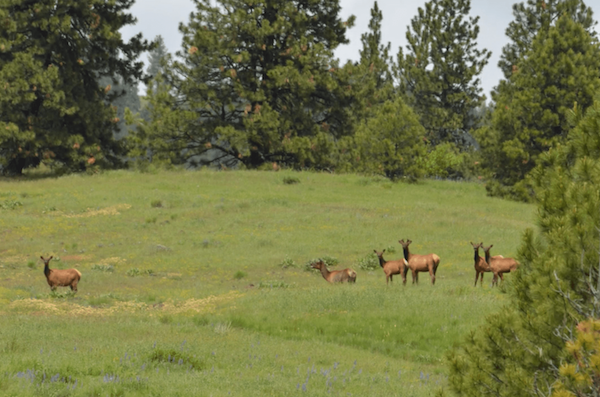Cougar Attack Victim At Home; Blues Cat Tag Increase Bid Pushback
The 9-year-old girl attacked by a cougar in Northeast Washington has been released from the hospital and is recovering at home, according to her uncle.
Alex Mantsevich said his niece Lily Kryzhanivskyy was discharged June 3, a week after the attack that occurred while she was playing hide-and-seek with other girls at a church camp in southwest Stevens County.
Though her fingers were still wrapped up, at home she was able to open presents, play the piano and share stories about the incident, he stated.

“We thank everyone of you for praying and supporting Lily on her path to recovery. She has many appointments scheduled already and she need your support and prayers. Her left eye is slowly opening, like 1/8 inches, but we pray for full recovery,” Mantsevich reported last Saturday.
As of this writing, his Go Fund Me campaign has raised over $101,000 for Lily and her mother for medical expenses and time off.
The mauling – the lion was shot and killed at the scene of the attack – also rekindled debate about Washington cougar management.
“Sorry to say, it’s proving what we’ve been saying for quite some time now. There are too many cougars out there. We’re going to have increased incidents,” Dale Magart of the Northeast Washington Wildlife Group told Eli Francovich for a Sunday article in the Spokane Spokesman-Review.
The secretary of the Colville-based organization pointed to increased lethal removals of cougars to address human safety issues, according to the reporter, who wrote that state game wardens killed 10 of the big cats in Stevens County in 2019, 14 in 2020 and seven in 2021.
A high-ranking WDFW officer said he hasn’t seen any discernible long-term trends and that incidents occur somewhat randomly and are “extremely rare.”
The agency takes that tack – Lily’s father considered it a “freak accident,” per the article – as the historical record shows, and offers tips on its website to prevent conflict with cougars.
That’s all well and good, but personal responsibility also shouldn’t rule out the need for WDFW to take action when necessary, Fish and Wildlife Commissioner Kim Thorburn told Francovich.
“It concerns me that we if we focus solely on education and outreach and individual responsibility, it detracts from asking questions about population approaches,” she told the reporter.
Thorburn chairs the commission’s Wildlife Committee and during a meeting earlier this month, she took a moment to acknowledge the cougar attack on Lily.
The full commission will take up a population approach at its June 23-25 meeting in Olympia, when a WDFW staff proposal to increase the cougar limit in the Blue Mountains to two a year will have a public hearing.
The bag boost is in response to critically low elk calf survival in the Southeast Washington herd, where a capture-and-collar project initiated last May found just nine of 125 young wapiti survived their first winter and predation was determined to be the primary cause. Seventy-seven were killed by cougars, bears, wolves and other wild predators, with at least 55 of those calves taken down by lions.
WDFW has begun a second year of captures and recently completed the ground-based effort with the collaring of 45 calves, according to spokeswoman Staci Lehman in Spokane. Aerial work will commence this Friday, she said, with the ultimate goal of monitoring another 125 calves.
But doubling the cougar limit has been pushed back on by hunters and others, who point out it is largely pointless without hounds – banned by a statewide initiative in the 1990s – and cat quotas in the Blues would remain the same as before.
“It’s all lipstick on a pig,” Jay Holzmiller, a former Fish and Wildlife Commissioner from Asotin County, told Eric Barker of the Lewiston Tribune. “The biggest thing that screws us all the time is we hit the quota.”
On the northeast side of the mountains, that guideline is seven to nine cougars; on the western side, it’s six or seven; and in the southeast, it’s five or six. The ranges correspond to 12 to 16 percent of the cougar population.
Only one of the three Blue Mountains population management units met its quota before the end of this year’s winter season.
Mark Pidgeon, president of the Hunters Heritage Council, called the proposed tag increase a “con” and “shell game” in a message to the commission.
“You could give us a hundred tags per hunter, but until you increase the harvest quotas percentages per PMU, you haven’t given us a thing,” he wrote.
In spring 2015, the commission did raise the cougar harvest guideline to 17 to 21 percent of the population for Northeast Washington units where wolves were present, but that fall and in response to environmental and animal-rights groups, Governor Inslee told the citizen panel to put it back at 12 to 16 percent.
Between that, the pushback and the Inslee commission majority’s hesitance to use predator hunting as a management tool – the 2022 spring black bear permit season for the Blues (and elsewhere) was twice kiboshed but could have hazed bruins during the elk birth pulse – WDFW’s proposal could be DOA.
A final decision is scheduled for July 15. Stay tuned.
